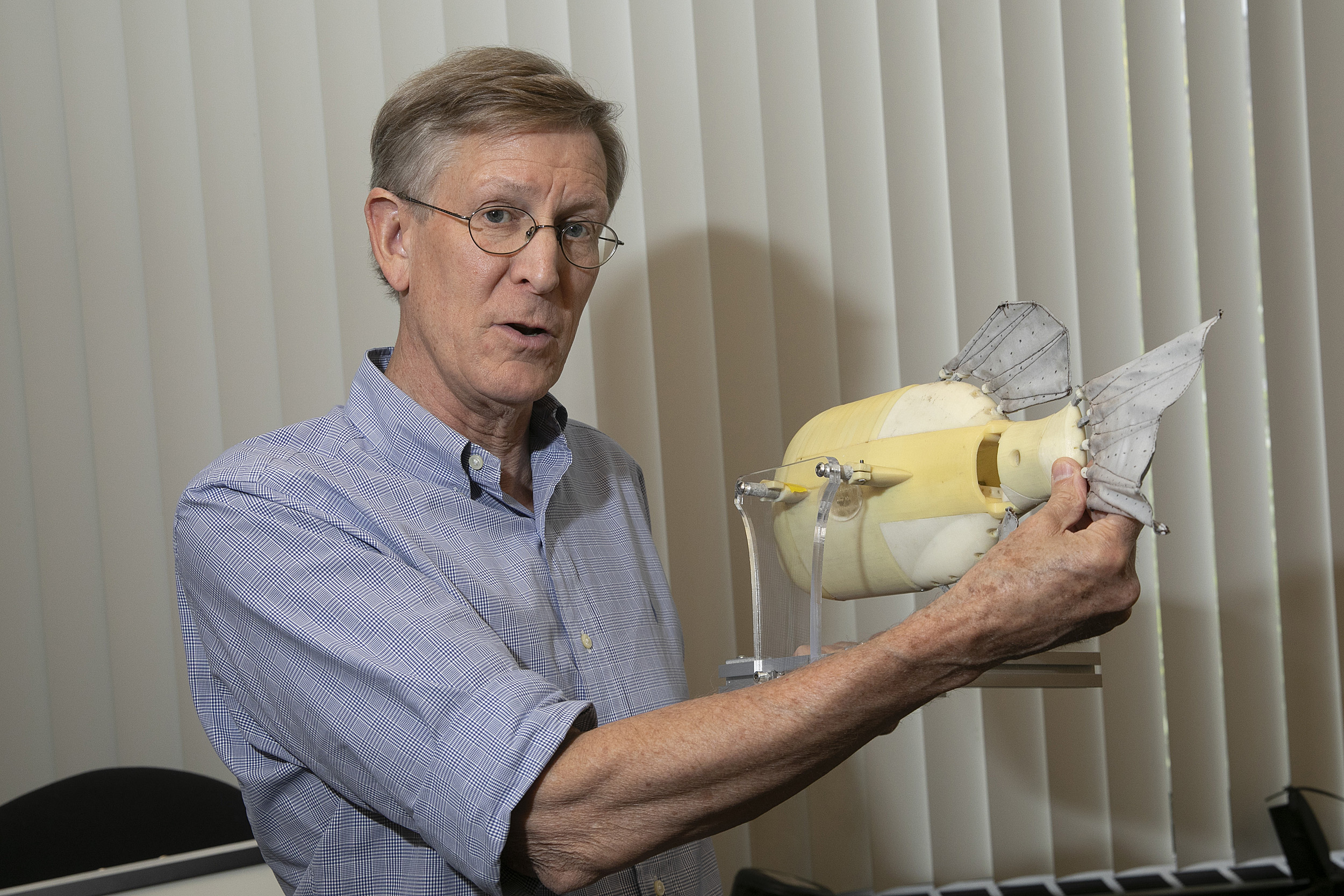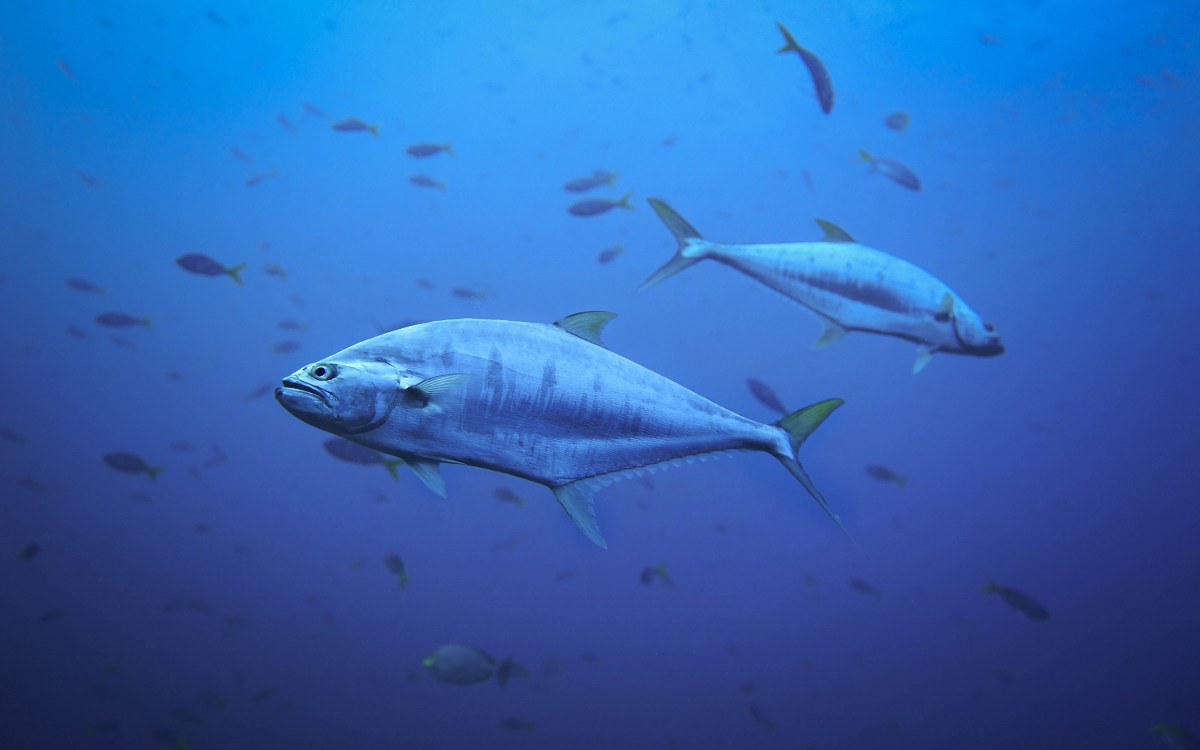
“It’s like a Porsche going through Cambridge traffic,” George Lauder said about the “Tunabot” he helped to develop. “It’s not going 100 miles per hour, but it can go to the track and perform at a high level.”
Jon Chase/Harvard Staff Photographer
Both marathoner and sprinter
With capacity for long-range efficiency and short bursts of speed, ‘Tunabot’ can illuminate the physics of how fish move
The best human runners specialize — with some devoted to covering ultra-long distances while others focus on lightning speed over a matter of yards.
In the open ocean, though, tuna can do both — as highly efficient swimmers, they’re able to migrate thousands of miles across the Pacific from California to Japan, but when threatened or on the hunt, they’re also among the fastest fish in the water, capable of reaching speeds of nearly 50 miles per hour.
But for scientists, like George Lauder, who hope to better understand how fish move by developing robots to model their underwater “gait,” that flexibility has been maddeningly difficult to capture until now.
The Henry Bryant Bigelow Professor of Ichthyology, Lauder and a team of researchers from the University of Virginia developed “Tunabot,” the first robotic tuna that can accurately mimic both the highly efficient swimming style of tuna and their high speed. The robot is described in a paper published in Science Robotics.
“People have come up with some complicated ways of building fish robots. Some can move pretty quickly, but they take large amounts of power,” Lauder explained. “We wanted to create something that could approximate the energy demands on the fish and move efficiently over a range of speeds.
“It’s like a Porsche going through Cambridge traffic,” Lauder said. “It’s not going 100 miles per hour, but it can go to the track and perform at a high level. Tuna are basically like the Porsche, they’re high-performance fish that have the capability of moving relatively slowly and efficiently, but they’re happy to ramp it up.”
The challenge, Lauder said, was in designing a mechanism that could efficiently convert the rotation of a motor into the side-to-side flapping of a fish tail — and the solution proved to be surprisingly simple.
Powered by an iPhone battery, the Tunabot can swim as far as about 5½ miles. It’s also capable of very quick motion, flapping its tail as many as 15 times per second.
Video courtesy of George Lauder
“A team led by Hilary Bart-Smith, a professor in UVA Engineering’s Department of Mechanical and Aerospace Engineering, did it by attaching a bent shaft to the motor,” Lauder said. “So it’s extremely simple, and it turned out to be very effective and very power-efficient. The whole thing only costs about $100.”
And with tests performed in Lauder’s lab, the UVA team was able to show the robot’s performance and power consumption are similar to that of live fish.
In fact, Lauder said, Tunabot was so energy-efficient that, with only the power supplied by an iPhone battery, it could swim as far as about 5½ miles. The same robot, though, was also capable of very quick motion, flapping its tail as many as 15 times per second.
“You can think of it like miles per gallon, essentially,” Lauder said. “We want something that’s fish-like in performance so we can understand how the tail of a tuna fish works, so we can visualize the flow over the tail, and that’s hard to do in a live tuna.”
That’s not to say the team didn’t compare Tunabot to its biological cousins.
“We compared this quantitatively to data from live yellowfin tuna,” Lauder explained. “There is a group in Rhode Island that is raising yellowfin tuna, and we were able to go there and compare the robot with 2-meter-long tuna. That’s unusual, for a robotics paper to have quality biological data for precise comparisons.”
Ultimately, Lauder said, the hope is that the Tunabot will help shed light on the biomechanics of how open-ocean fish swim.“That’s always been one of the goals of the project,” he said. “There are a number of fish robots that have been designed for a variety of purposes, but … it’s been hard to develop robots that in any way approach the performance of open-ocean fish. The idea of exploring this high-speed performance space, that had not been done before, and that’s our major contribution.”
This research was supported with funding from the Office of Naval Research and the David and Lucile Packard Foundation.








